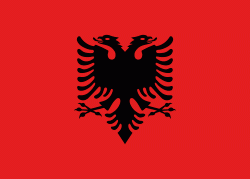Petrelë
Petrelë is a village and a former municipality 15 km south of Tirana, in central Albania. It is part of Tirana County. At the 2015 local government reform it became a subdivision of the municipality Tirana. The population at the 2011 census was 5,542. It is known for its castle and history.
According to Moikom Zeqo, Petrela was previously called Petralba, and that name evolved from Albanopolis, a Roman-era city mentioned by Ptolemy. The name Petrelë comes from the fact that the town and its castle are built on a huge stone on top of a small mountain. Halfway up the hill on which Petrela is situated are the remains of defensive walls which comprise terracing operations on the S, E, and W sides; above each section is a level area. On the best preserved, which is on the W side, rises a building to a height of 5 m and to a length of 20 m. The walls form a double ring, of which the outer section is built of square blocks which form a pseudo-isodomic structure strengthened by buttresses. In the vicinity, fragments of Hellenistic pottery have been discovered.
The tower in the center was built in the 5th century AD, although most of the remainder is Byzantine, dating from between the 11th and 14th centuries. The castle was used mostly to watch for Ottoman troops marching towards inner Albania. In Ottoman times, the castle was the house of Scanderbeg's sister (Mamica Kastrioti). The town and castle were also very dear to Scanderbeg, and he used to take time off to come and rest in the area.
The castle has views of the Erzen valley, the hills, olive groves, and surrounding mountains.
According to Moikom Zeqo, Petrela was previously called Petralba, and that name evolved from Albanopolis, a Roman-era city mentioned by Ptolemy. The name Petrelë comes from the fact that the town and its castle are built on a huge stone on top of a small mountain. Halfway up the hill on which Petrela is situated are the remains of defensive walls which comprise terracing operations on the S, E, and W sides; above each section is a level area. On the best preserved, which is on the W side, rises a building to a height of 5 m and to a length of 20 m. The walls form a double ring, of which the outer section is built of square blocks which form a pseudo-isodomic structure strengthened by buttresses. In the vicinity, fragments of Hellenistic pottery have been discovered.
The tower in the center was built in the 5th century AD, although most of the remainder is Byzantine, dating from between the 11th and 14th centuries. The castle was used mostly to watch for Ottoman troops marching towards inner Albania. In Ottoman times, the castle was the house of Scanderbeg's sister (Mamica Kastrioti). The town and castle were also very dear to Scanderbeg, and he used to take time off to come and rest in the area.
The castle has views of the Erzen valley, the hills, olive groves, and surrounding mountains.
Map - Petrelë
Map
Country - Albania
 |
 |
| Flag of Albania | |
Albania has been inhabited by different civilisations over time, such as the Illyrians, Thracians, Ancient Greeks, Romans, Byzantines, Venetians, and Ottomans. The Albanians established the autonomous Principality of Arbër in the 12th century. The Kingdom of Albania and Principality of Albania formed between the 13th and 14th centuries. Prior to the Ottoman conquest of Albania in the 15th century, the Albanian resistance to Ottoman expansion into Europe led by Skanderbeg won them acclaim over most of Europe. Albania remained under Ottoman rule for nearly five centuries, during which many Albanians (known as Arnauts) attained high-ranking offices in the empire, especially in the Southern Balkans and Egypt. Between the 18th and 19th centuries, cultural developments, widely attributed to Albanians having gathered both spiritual and intellectual strength, conclusively led to the Albanian Renaissance. After the defeat of the Ottomans in the Balkan Wars, the modern nation state of Albania declared independence in 1912. In the 20th century, the Kingdom of Albania was invaded by Italy, which formed Greater Albania before becoming a protectorate of Nazi Germany. Enver Hoxha formed the People's Socialist Republic of Albania after World War II, modeled under the terms of Hoxhaism. The Revolutions of 1991 concluded the fall of communism in Albania and eventually the establishment of the current Republic of Albania.
Currency / Language
| ISO | Currency | Symbol | Significant figures |
|---|---|---|---|
| ALL | Albanian lek | L | 2 |
| ISO | Language |
|---|---|
| SQ | Albanian language |
| EL | Greek language |















